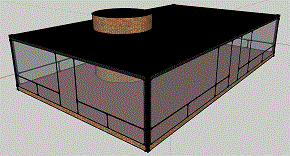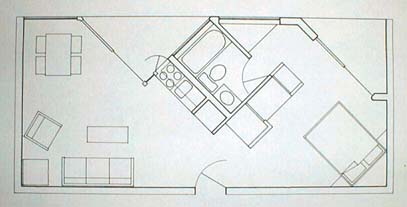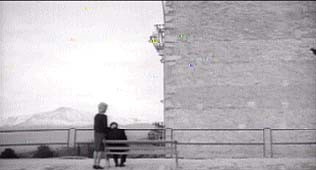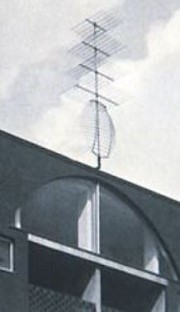Why I (BMcC[18-11-46-503]) did not go to Master of Architecture School (1982)
Kitsch is not technically inept art; kitsch is unethical art. (Hermann Broch, paraphrase)
In ancient Egyptian mythology, "the West", where the sun goes down, is the Land of the Dead.
This is going to be a story, the sorrow and the pity of which can only be exceeded by
historically important things like the architect Louis I. Kahn dying (heart attack) like a stray dog in a toilet stall
in a men's room in New York City's Pennsylvania railroad Station. Elie Wiesel said: Don't compare; all suffering is intolerable.[1]
When I was a child, I wished my parents lived in an more architecturally interesting house. Does that count for nothing? Here's the kicker: My parents paid probably more than they could afford for a banal, boring SPLIT LEVEL in an upscale neighborhood, by a sleazeball a**hole contractor (Max Muller), when right across the street was a lovely small house being built on spec by one of the the neighborhood's two first-rank contractors, that looked more architecturally interesting and its price was several thousand dollars cheaper (it was bought by a Baltimore harbor pilot). Ignorant, clueless people spend more money to get less than more highly educated, cultured persons who earn less. It's the way of this world, and I was stuck with the former. My road to hell was paved with their [presumably?] good intentions.[2]
It must have been 1981, when I made a secular pilgrimage to the Yale Architecture School in New Haven CT to discuss the possibilities of myself, a B.A. graduate of Yale College (with a diploma labelled "Summa cum Laude" and Honors with exceptional distinction in philosophy, even) gaining admission to Yale's Master of Architecture program. I spoke with the Director of Admissions: Professor Martin Gehner. He explained to me that I lacked evidence of architectural aptitude. He suggested that I attend Harvard's non-credit 6 week summer Career Discovery Program; I did as advised.
In 1982, I took 6 weeks off from my computer programmer job at IBM Research, and spent 6 weeks in Cambridge MA. My only experience with Harvard, because I had earlier been rejected for undergraduate admission due to not fitting their quota system which favored a person who would be an asset to their varsity lacrosse team.
Career Discovery in Architecture was deeply engaging for me. Seven days each week I was still in the Architecture School building (Gund Hall) after everybody except the night watchman had left, and back the next morning before anybody else. The program consisted of 6 design assignments coupled with faculty lectures on various architectural subjects. (There were no seminars.)
The lectures were a mixed bag. I learned about Andreas Palladio's villas. They probably
lectured also about other, to myself less inspiring, things. I forget what. They did not talk
about Louis Kahn, "Less is more" [Mies van der Rohe], Adolf Loos or other topics of interest to me.
But, "what the heck"? I was used to over-long boring meetings, from my computer programmer work experience.
The first project was to design a student apartment, including a pre-fabricated 8 feet square "service module" cube, with a predefined square-footage limit and urging inclusion of internal balconies up to another square-footage limit. I struggled with the project, including thinking up at least one banal design which for that reason I rejected. Finally, somehow, the notion "came to me" to turn the service cube at a 45° angle (see immediately above).
After that, everything followed quickly. I went through many "imaginative variations" (ref: Edmund Husserl, passim). Everything seemed to work. I imagined myself living in what I had designed, and I liked how I/it felt. My main question: Was the width of the passage from the left side to the right side of the service cube wide enough? After trying to lay this out on the floor inside and outside the 2nd Floor Gund Hall unisex toilet room, which was adjacent to my drawing board space, I concluded it probably was wide enough. (If you look carefully, my reader, you will find a flaw in my design: The blanket fold on the bed is wrongly articulated.) Apart from that, now some 40 years later, I believe my solution to this little design problem was and remains exemplary (albeit I now see a further detail enhancement anent the balcony area next to the bed; also see a real architet's implementation of the same basic design, here). I cannot recall if the faculty persons involved in 1982's Career Discovery Program expressed any opinion about my work (I think they were all Graduate students making a buck -- but the person assigned to shepherd my student group, Sophia Gruzdys, was decent; she had a motto: "I like white walls, don't you?").
As said, there were six projects. I will here consider only the one other that I feel deeply proud of. Concerning the other 4, I recall I did something I was also proud of on two, really screwed up on another, submitting something that was much overly complicated and had only the virtue of being "Modernist"[10]. and I totally forget the last one. Back to the project submission I felt was most honorific[3] (above top).
This was a project to design a building ("Le Pavilion d'Un") with exactly one of each architectural element, to house one obscure rare book. Thought rigorously, such an assignment is as absurd as a perpetual motion machine: If there was a door, would it be required to have only one hinge connecting the door to its frame? One screw in the hinge? What counts as an "architectural element"? I did not think at the time to ask: "Where does one draw the line?" (pun intended)
I decided to take the requirement loosely. If seven days were allotted to this project, I expended 6 of them on dead ends. It was 4th quarter with seconds to go on the clock and I was behind 6 0. I finally decided to try to turn defeat into victory. Somehow, a to myself familiar trope from my feelings about the "prep" school I had attended as a teenager came to my mind: General Curtis Lemay would bomb the project and turn something bad into something neutral: a hole in the ground. I soon realized I had won the game! It was a short step from Lemay to Sherman, and to recall some touching words I had read from the diary of a Confederate matron who had experienced General William Tecumseh Sherman's through Georgia "march to the sea", Mary Chestnut:
"Thomas, Daniel says, was now to ravage Georgia, but Sherman, from all accounts, has done that work once for all. There will be no aftermath. They say no living thing is found in Sherman's track, only chimneys, like telegraph poles, to carry the news of Sherman's army backward." (Mary Chestnut, 26 Feb 1865. A Diary From Dixie: Electronic Edition. Mary Boykin Miller Chesnut, 1823-1886, Academic Affairs Library, UNC-CH University of North Carolina at Chapel Hill, 1997)
I imagined a Georgia plantation mansion, razed by Sherman's troops, with only the (one) foundation remaining, and: one chimney, one set of stairs leading to one small entrance porch leading to one now no longer existent front door, etc.
The banality of oneness was not, however, what interested me most about this project. The project spec had included guidance that the [one] rare book to be housed in the building was unreadable because its content was semantically obscure. This smelled possibly suspicious to me (I very much wanted to know the secret the book held!), so I went to the main Harvard library (Widener) and did some investigating. I discovered that the difficulty with the book was that it was execrably printed, not noetically difficult. I reported this to Chief. He did not indicate pleasure in my discovery. (Obviously, I was not pleased with him, but I could not tell him to shape up.)
I made a bigger mistake: Instead of focusing narrowly on architectural appearances, I thought: I related my design to The Destiny of Western Civilization. Let me add some context here: 1982 was near the advent of postmodernist architecture, where the Holy Grail was to put lipstick on a pig (pace piggies!), i.e.: to: "decorate sheds" (C&CinA, passim).
A person who is incapable of creating anything can still decorate something.
I thought that the [one] window in my building (not visible in the present picture[4]) looked out over the rubble, past the now deconextualized chimney, West. In the late afternoon, a person studying the book in the building could contemplate the sun setting on Western civilization (fantasized view, here). Look into the building from an angle which shows how this works: here.
In class, when they went from one student after another to stand up and speak to the class on his or her project, I spoke about persons in my building reflecting on the decline of Western Civilization.[9] Next student!
What I said and wrote about "The decline of The West" here from 1982 needs to be updated for 2023: The then unanticipated new age of anti-intellectual anti-European civiliation neo-ehnicistic Wokism (e.g.: here).
I was not defending"European culture" in the sense of white middle-aging males who wear armani suits not constumes of rare bird feathers and who dance around a CEO's desk not a totem pole, or slave raders who did business with African tribal chiefs who sold their own people to them. I reject all ethnicities, including that one in which I find myself physically stuck, which is sometimes called:"The American Dream".
I was and still am lamenting that the human beings who mostly were born in Europe and America have not transcended all ethnicities including the ones of their own parents and into which they themselves were childereared, to create their own self-accountable self-shaped form of living for which all the social customs and beliefs of all cultures throughout human history serve only as semiotic raw material for them to salvage on a take it or leave it basis.
What I am lamenting is that white males and females and others believe in any religion instead of being sociologists of all religions, wave any country's flag instaed seeing all patriotisms as irrational partisanships to be studied not supported, etcetrea and so forth.
Insofar as Europe remained "European" as opposed to, say, "Igbo" and not anthropological, I saw and still see it as in decline. for me, only a Europe which is always evaluating its own customs and beliefs as disinterestedly as the customs and beliefs of tribes that went extinct tens of thousands of years ago or are on the other side of some politician's "Iron Curtain" is not in decline. Don't "honor thy father and mother". Critically evaluate them. Unflinchingly ask yourself: Can I justify believing what I believa or can I find or invent something better? Only then are you a European in my sense.
This was not the end of the story. I asked Chief what would be my prospects, were I to apply for admission to Harvard's Master of Architecture program. He responded that when they admitted students like myself they "left after a year without have to be asked to." You, my reader, may guess I did not apply to Harvard.
Career Discovery ended. I went back to my computer programmer job in IBM Research, Yorktown Heights NY[5]. I collected all my drawings from the program, sought out the highest quality architectural document photo reproduction company I could find in New York City, and had reproductions made of my student drawings. Not cheap, but I had savings ($110 USD?). I visited Yale again, and Professor Gehner told me I had not exhibited freehand drawing ability. And he told me an admonitory story about a Yale M.Arch loser: a man who had no freehand drawing skill and consequently flunked out of the program after one year. I had the presence of mind to ask what happened to said person after that. The man then took a freehand drawing course at a local junior college, came back to Yale and earned his M.Arch degree. ∴ I did not apply to Yale. Professor Gehner, you surely have forgotten me, but I have not forgotten you, as a model for what/who a teacher should not be. ☠
Allow me an aside here: I did apply to and was accepted by several low-status M.Arch. programs. I had to reject all these offers. Why? Because I knew I could not "hack" maintaining my bodily existence ("pragmatic agenda") by myself, and none of these universities had dormitories for architecture graduate school students. End aside. I applied to Princeton. I got a lovely recommendation from Hermann Broch's son, in which he noted his father had lived in Albert Einstein's house.[6] I made the waiting list, but apparently acceptances were high that year, so I did not get into Princeton.
At age 74 years, now, I think all the freehand drawing adepts were probably correct. Especially in the technological Dark Ages before CAD-CAM computer programs, my total lack of freehand drawing aptitude [contrast: my mother had idiot savant artistic talent] would probably have doomed me. Was I, consequently, architecturally worthless?
I think I was not worthless. I loved/still love architecture. I studied/still study it. I savored/still savor good architecture and abominated/still abominate bad architecture. At Teachers College Columbia University, a few years after my ill-fated adventure into M.Arch-land, I took a course from endowed chair Professor Maxine Greene: Esthetics in Education. I told Professor Greene I wanted to write an essay on morality in modern architecture instead of doing the course assignments. She said to me to Go do it! She gave me an "A+" for the paper I submitted, which asserted, and adduced evidence:
• Louis Kahn was an ethical architect. He designed buildings to enrich the lives of the persons who used them, with the aim of the persons living lives of desire not just need. I quoted his words from John Lobell's book: "Between Silence and Light".
• Philip Johnson was an amoral architect. He designed buildings that just looked pretty, apparently without thinking much about the lives of the persons who used the buildings, one way or the other. I cited his New York City AT&T building – the so-called "Chippendale skyscraper" – as an example.[7]
• Robert Venturi was a cynically immoral (unethical) architect. He promulgated architectural theory advocating mendacity: decorating sheds ("Complexity and Contradiction in Architecture", "Learning from Las Vegas"). I analyzed an example of his work: GUILD HOUSE, which secretly mocked its users: aged Quakers. One Item: Mr. Venturi explains that the building is topped off with a gold anodyzed TV antenna (right) which is a "symbol for the elderly who watch so much television". Not all aged Quakers are superannuated couch potatoes with Alzheimer's disease.
I now think I might have had something of value to bring to 20th century architecture, which I think many successful architects (not all! Item: Louis I. Kahn) lack: philosphical reflective thinking: "Bauen Wohnen Denken" ("Build to dwell to think", Martin Heidegger). The MArch program university admissions officer beneficiaries of high privilege of Western Civilization should have had the wits about themselves to realize what I needed: to be a student in a Ph.D. program in the Philosophy of Architecture. No such program existed? They could have given me the dissertation project of creating the program.
But maybe I misunderstand them. Maybe they only had Ronald Reaganomic instruction in advanced job skills without some "intellectual luxuries"? Damn them all![8] And thus save all the persons who live upon earth from more of their contributions to The Decline of The West! "You have us duly licensed architects all wrong, you politically incorrect a--hole! Shame on you!" "Show me I'm wrong, please, and I will apologize to each and every one of you for my ignorance and unfair assessment of your [lack of] character."
That, my reader, is the end of my story about trying to become an architect. If I had the money and it was available, I would buy Mario Botta's Bianchi House at Riva san Vitale (1973, Switzerland), or I'd RYO. What do you think? bmcc.edd@gmail.com
Footnotes
- ↑ Some quotes anent suffering, from various points of view.
- ↑ Edmund Husserl's philosophy is based on the idea of intentionality, It must be understood that there need be nothing honorable, only factual, in this: A person can intend to eat a Dunkin Donut. That qualifies.
- ↑ As will be elaborated, shortly, I am not certain the Chief graduate student in charge of all the graduate assistants' vocabulary included such words as: "honorific".
- ↑ I later coded up a VRML (Virtual Reality Markup Language) simulation of my design, in which everything could be seen from various perspectives and one could open the door and walk into the building, study my rare book, "The Summoning of Everyman", and look out on the chimney....
- ↑ Aside The IBM Yorktown Research Center was designed by Eero Saarinen. From experience working there for a couple years, I attest it is a great humanistic building. Its design encourages employees to THINK creatively.
- ↑ More about Broch's son: He was a perhaps 80 year old Old World aristocratic gentleman, fighting pernicious anemia. Not a playful kitten. He designed a tree house and sent his drawing to me; I believe I had motivated him to do his little architectural design project. [I deposited this item, along with my other correspondence with "H.F. Broch de Rothermann", into his archive in Yale's rare book (Beinecke) library.]
- ↑
 I later read that when Mies van der Rohe, who said "God is in the details", visited Mr. Johnson's famous "Glass House", he walked out in disgust at the low quality of the detailing. Mr. Johnson's Glass House is also probably the only work of domestic architecture ever inspired by the Civil War ironclad warship USS Monitor, which had a revolutionary cylindrical rotating gun turret like the bathroom in the Glass House, whch floats on the Connectiut landscape.
I later read that when Mies van der Rohe, who said "God is in the details", visited Mr. Johnson's famous "Glass House", he walked out in disgust at the low quality of the detailing. Mr. Johnson's Glass House is also probably the only work of domestic architecture ever inspired by the Civil War ironclad warship USS Monitor, which had a revolutionary cylindrical rotating gun turret like the bathroom in the Glass House, whch floats on the Connectiut landscape. - ↑ Reference here is to the last 3 monosyllabic words of George Steiner's essay on the British art historian traitor Sir Anthony Blunt.
- ↑ When I spoke about "the Decline of The West" here, I don't think I was so much implying that the present was degrading fron some better past, but rather that the present was betraying the possibiities first thought such as in Heraclitus's fragments and later in Edmund Husserl's "Vienna lecture" (1935). A good image here is how you can feel you are always falling when you are drunk and empirically you are standing on a solid unmoving surface. This reminds me of the famoout Francis Bacon painting of Pope Innocent X. Also the line from Laurie Anderson's "America I-IV" (1984), citing from imperfect memory: "This is your Captain speaking. Please pleace raise your seats and place you tray tables in the upright locked position. Fasten your seat belts. Put your head between your knees. We are going down. We are all going down together...."
- ↑ December 2023 I finally found the solution to this problem, which was to design a house for a vacant lot on the street behind Gund Hall: picture here. I was browsing thru miscellaneous PInerest picures and as soon as I saw it I immediately recognized it was the solution:

This must have been how Admiral McCain felt when saw Isadore Znamirowski's solution to the problem to design a new insignia for U.S. aircraft to avert friendly fire aerial combat shootings in World War II: "We got it! Take it up!"

 Welcome
Welcome![Harvard Career Discovery project to design a building to house a single obscure rare book. My solution is a study space situated over the ruins of a Confederate mansion razed by General Sherman's army during what has been called "the first modern war" ("Marching through Georgia", although General Sherman reserved his greatest wrath for South Carolina which had started the Rebellion). The building has a large window, not visible here, facing West, looking out over the still standing chimney, to facilitate reflective thinking about The Decline of the West [Abendland], especially, the postmodern condition and, now in 2022, Wokism, while watching the sun go down. (Click next-pointer for detail)](w/images/1/1d/Onea.jpg)

![Americans moved into Levittowns! Levels were split! Lawns were mowed! Mary Hartman saw the waxy yellow buidup on her kitschen floor! Big Macs were eaten! SUVs flourished! Americans got in their cars, and commuted (not death sentences)! We were: "Runnin' on empty, runnin' around!" (ref.: Jackson Browne song) ~ America's greatest contribution to the history of world architecture: The single family split level [or raised ranch...] suburban tract development house on 1/4 acre or more of grass lawn so why not just make it astroturf?](w/images/a/ab/SplitLevel.jpg)



